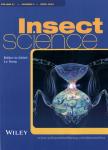Diversity of secondary endosymbionts among different putative species of the whitefly Bemisia tabaci
Diversity of secondary endosymbionts among different putative species of the whitefly Bemisia tabaci作者机构:Ministry of Agriculture Key Laboratory of Agricultural Entomology Institute of Insect Sciences Zhejiang University Hangzhou College of Chemistry and Life Science Zhejiang Normal University Jinhua Zhejiang Province China
出 版 物:《Insect Science》 (昆虫科学(英文版))
年 卷 期:2013年第20卷第2期
页 面:194-206页
核心收录:
学科分类:0710[理学-生物学] 0830[工学-环境科学与工程(可授工学、理学、农学学位)] 09[农学] 0903[农学-农业资源与环境] 0904[农学-植物保护] 0901[农学-作物学] 090402[农学-农业昆虫与害虫防治] 0713[理学-生态学]
基 金:provided by the National Natural Science Foundation of China Qianjiang Talent Plan 国家973计划
主 题:Arsenophonus Cardinium Hamiltonella Rickettsia whitefly Wolbachia
摘 要:Endosymbionts are important components of arthropod biology. The white- fly Bemisia tabaci (Gennadius) (Hemiptera: Aleyrodidae) is a cryptic species complex composed of 〉28 putative species. In addition to the primary endosymbiont Portiera aley- rodidarum, six secondary endosymbionts (S-endosymbionts), Hamiltonella, Rickettsia, Wolbachia, Cardinium, Arsenophonus and Fritschea, have been identified in B. tabaci thus far. Here, we tested five of the six S-endosymbiont lineages (excluding Fritschea) from 340 whitely individuals representing six putative species from China. Harniltonella was detected only in the two exotic invaders, Middle East-Asia Minor 1 (MEAM 1) and Mediter- ranean (MED). Rickettsia was absent in Asia II 1 and MED, scarce in Asia II 3 (13%), but abundant in Asia II 7 (63.2%), China 1 (84.7%) and MEAM1 (100%). Wolbachia, Cardinium and Arsenophonus were absent in the invasive MEAM1 and MED but mostly abundant in the native putative species. Furthermore, phylogenetic analyses revealed that some S-endosymbionts have several clades and different B. tabaci putative species can harbor different clades of a given S-endosymbiont, demonstrating further the complexity of S-endosymbionts in B. tabaci. All together, our results demonstrate the variation and diversity of S-endosymbionts in different putative species ofB. tabaci, especially between invasive and native whiteflies.



